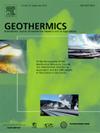Assessing the interaction of an energy tunnel with the underground thermal conditions in an urban area
IF 3.5
2区 工程技术
Q3 ENERGY & FUELS
引用次数: 0
Abstract
In the very shallow depths of urban areas it is difficult to find natural undisturbed underground thermal conditions because of anthropic interventions. Moreover, these areas are being increasingly used for energy purposes, for example implementing the technology of shallow geothermal systems to provide clean thermal energy and supply the thermal demand of buildings in both winter and summer seasons. The heat exchanged by these types of renewable energy technologies, in particular ground source heat pump systems such as open loop and closed loop ones, in combination with further anthropogenic activities, results in altered thermal regimes in the subsurface. Energy tunnels, which are achieved by thermally activating the tunnel lining, have recently gained attention among closed loop geothermal systems. Therefore, when planning an urban energy tunnel, attention has to be devoted to the initial underground thermal conditions and to the interactions the pre-existing thermal regime will have with the energy tunnel itself. To this aim, the paper outlines a methodological approach which is then applied to a case study in Turin, Italy, where a new metro line is planned. Thermo-hydraulic numerical modelling is adopted to reproduce the thermally disturbed subsurface environment in the study area prior to the energy tunnel’s thermal activation, due to the presence of multiple heat sources (open loop and closed loop systems, underground buildings, car parks and infrastructures), as well as after its commissioning. Results are illustrated in terms of temperature maps and cross sections where the thermally affected zones due to open loop, mainly, and closed loop systems are depicted depending on the operational mode of the shallow geothermal systems. Those results highlight that, when the installation of a new energy tunnel is envisaged, it is necessary to consider the current geothermal exploitation of the area and the operation of neighbouring similar systems.
评价能源隧道与城市地下热条件的相互作用
在城市地区的极浅深处,由于人为干预,很难找到自然的未受干扰的地下热条件。此外,这些地区正越来越多地用于能源目的,例如实施浅层地热系统技术,以提供清洁热能,并在冬季和夏季满足建筑物的热需求。这些类型的可再生能源技术,特别是诸如开环和闭环的地源热泵系统所交换的热量,与进一步的人为活动相结合,导致地下热状态的改变。能量隧道是通过热激活隧道衬砌来实现的,近年来在闭环地热系统中得到了广泛的关注。因此,在规划城市能源隧道时,必须注意初始地下热条件以及预先存在的热状态与能源隧道本身的相互作用。为此,本文概述了一种方法学方法,然后将其应用于意大利都灵的一个案例研究,那里正在规划一条新的地铁线路。采用热水力数值模拟再现研究区由于多个热源(开环和闭环系统、地下建筑、停车场和基础设施)的存在,在能量隧道热激活之前,以及在其调试之后的热扰动地下环境。结果用温度图和横截面来说明,其中主要由开环和闭环系统引起的热影响区根据浅层地热系统的运行模式进行了描述。这些结果突出表明,在设想安装新的能源隧道时,必须考虑到该地区目前的地热开发情况和邻近类似系统的运作情况。
本文章由计算机程序翻译,如有差异,请以英文原文为准。
求助全文
约1分钟内获得全文
求助全文
来源期刊

Geothermics
工程技术-地球科学综合
CiteScore
7.70
自引率
15.40%
发文量
237
审稿时长
4.5 months
期刊介绍:
Geothermics is an international journal devoted to the research and development of geothermal energy. The International Board of Editors of Geothermics, which comprises specialists in the various aspects of geothermal resources, exploration and development, guarantees the balanced, comprehensive view of scientific and technological developments in this promising energy field.
It promulgates the state of the art and science of geothermal energy, its exploration and exploitation through a regular exchange of information from all parts of the world. The journal publishes articles dealing with the theory, exploration techniques and all aspects of the utilization of geothermal resources. Geothermics serves as the scientific house, or exchange medium, through which the growing community of geothermal specialists can provide and receive information.
 求助内容:
求助内容: 应助结果提醒方式:
应助结果提醒方式:


